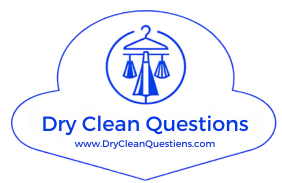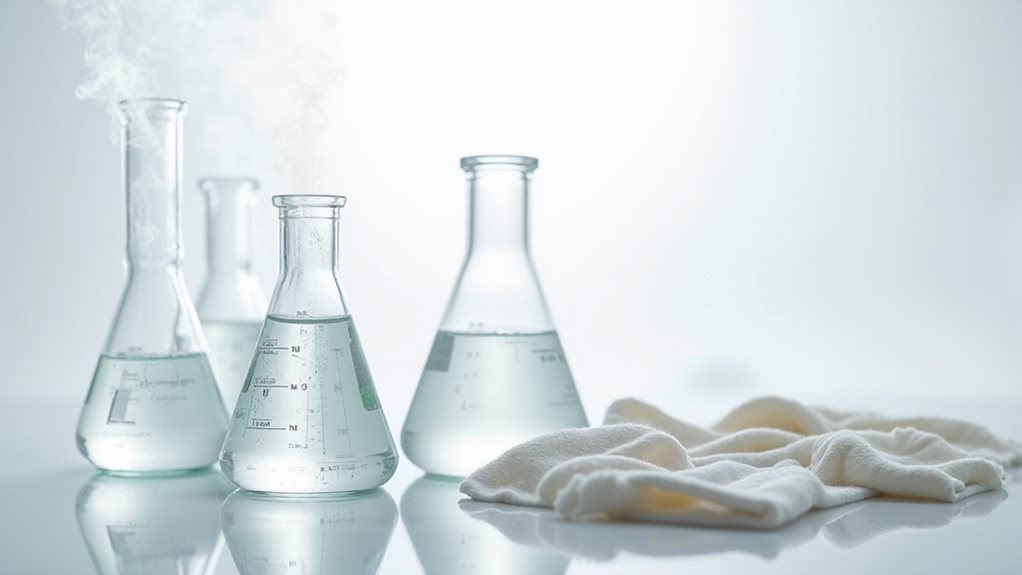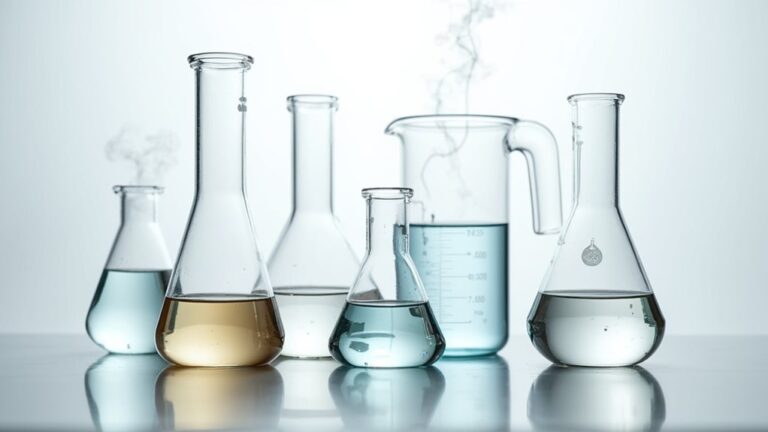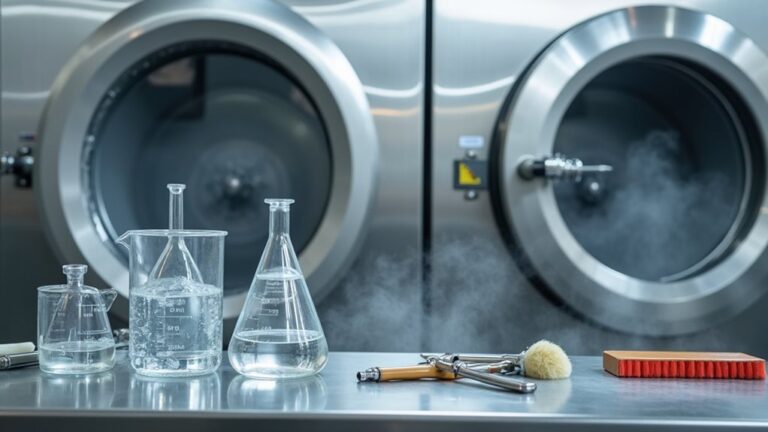Your dry cleaner most likely uses perchloroethylene, or “perc,” which dominates about 70% of American cleaners and effectively removes oil-based stains, though it’s classified as a possible carcinogen. You might also encounter hydrocarbon-based solvents (used by 20% of cleaners), eco-friendly siloxane that breaks down into harmless substances, or high-tech liquid carbon dioxide cleaning. Since most cleaners won’t volunteer this information, you’ll need to ask directly about their solvents to understand what’s touching your clothes and affecting your health.
Perchloroethylene: The Industry Standard Solvent
The workhorse of the dry cleaning world, perchloroethylene—or “perc” as we call it in the industry—has been quietly removing your toughest stains since your grandparents were young, dominating about 70% of American dry cleaners today.
The silent champion of stain removal, perc has been the backbone of American dry cleaning for generations.
This dry cleaning solvent earned its reputation through sheer cleaning performance, effortlessly dissolving oil-based stains that would make your washing machine wave the white flag in surrender.
When you’ve got grease-soaked work uniforms or that stubborn salad dressing disaster on your favorite blazer, perc steps up like a reliable friend who never asks questions.
However, there’s a darker side to this chemical champion—it’s classified as a possible human carcinogen and environmental pollutant, which honestly makes me cringe every time I think about decades of exposure.
PERC residues can linger on freshly dry cleaned garments, especially when proper airing out procedures aren’t followed after the cleaning process.
Alternative Hydrocarbon-Based Cleaning Solutions
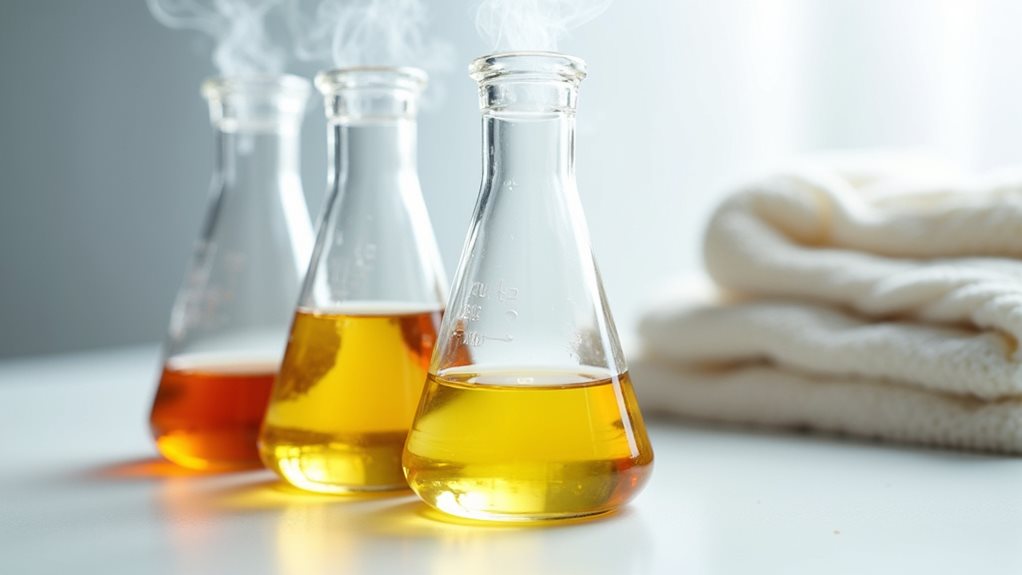
When environmental concerns started nudging the dry cleaning industry toward greener pastures, hydrocarbon-based solvents emerged as the friendly neighborhood alternative that promised to clean your clothes without the scary health warnings plastered all over perc.
These alternative solvents, marketed as “environmentally friendly,” still carry baggage—they’re volatile organic compounds that contribute to ozone formation, making them subject to similar regulatory pressure as their predecessor.
Here’s what you should know about hydrocarbon solvents:
- Synthetic petroleum derivatives used by 20% of cleaners raise respiratory concerns
- Aliphatic and aromatic types can reach 100% concentration for improved cleaning effectiveness
- Lower flammability makes them safer than perc, though cleaning power may suffer
- Consumer demand drives innovation despite marketing claims that don’t always match reality
Traditional options like Stoddard solvent and petroleum spirits continue to be employed in dry cleaning operations, though they come with their own set of environmental considerations that the industry must navigate.
Siloxane: The Gentle and Biodegradable Option
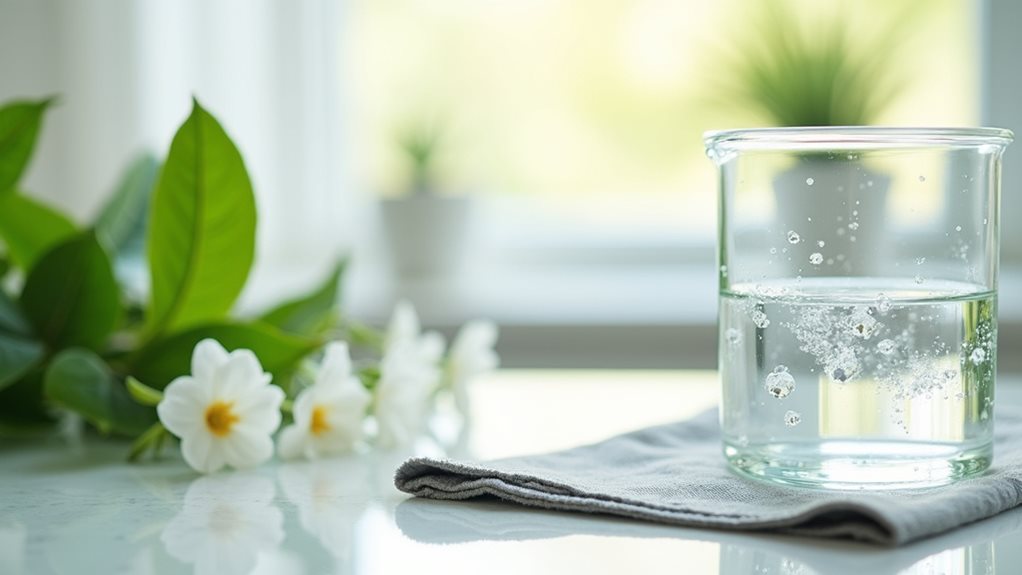
Innovation sometimes sneaks up on industries when they least expect it, and that’s exactly what happened when siloxane entered the dry cleaning scene like a quiet revolution that nobody saw coming.
You’ll find this biodegradable solvent breaks down into harmless silica and carbon dioxide, making it incredibly environmentally friendly compared to traditional chemicals that stick around like unwanted party guests.
What’s really impressive is how siloxane offers gentle cleaning without the harsh odors or skin irritation you might’ve experienced before.
Siloxane delivers powerful cleaning results while eliminating the unpleasant chemical smells and potential skin reactions of traditional dry cleaning methods.
Though fewer than 5% of cleaners use it currently, brands like Green Earth are proving that sustainable textile care doesn’t mean compromising quality – your delicate fabrics stay vibrant while you sleep better knowing you’ve chosen eco-conscious options. 🌱
For those looking to reduce their reliance on chemical solvents entirely, steam cleaning provides another environmentally conscious approach that uses high-temperature water vapor to remove dirt and odors without any chemicals at all.
Carbon Dioxide Dry Cleaning Technology
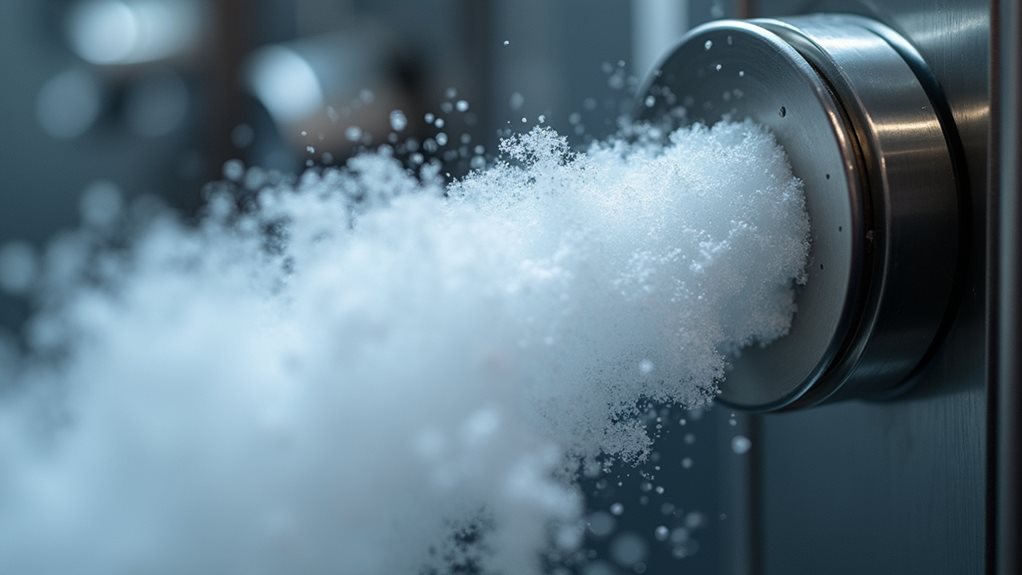
While siloxane represents a beautiful step toward gentler cleaning, carbon dioxide technology takes sustainability in a completely different direction that honestly surprised me when I first learned about it.
You’re fundamentally using liquid carbon dioxide as your solvent, which transforms from gas under high pressure during the dry cleaning process.
Here’s what makes this environmentally friendly approach fascinating:
- The liquid carbon dioxide swells fabric fibers naturally, releasing embedded dirt without harsh chemicals
- Modern dry cleaning machines recover most CO2, though each cleaning cycle still releases 6-10 pounds
- It’s remarkably gentle on delicate fabrics while maintaining their integrity beautifully
- The method excels at rinsing but struggles with stubborn stain removal compared to traditional solvents
The main drawback? Those dry cleaning machines cost considerably more upfront, making this technology less accessible for smaller operations.
In contrast to CO2 systems, petroleum-based solvents like Stoddard solvent and white spirit excel at removing oils and greases through their lipophilic dissolving properties, though they require enhanced fire safety protocols due to flammability concerns.
Health and Environmental Considerations of Dry Cleaning Chemicals
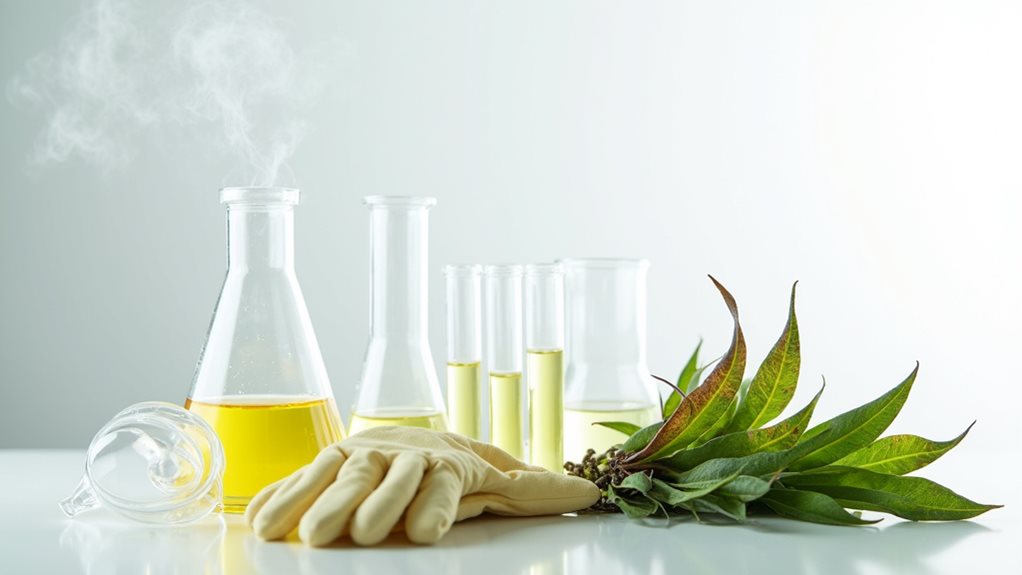
When you’re choosing a dry cleaner, you’re probably not thinking about the hidden health risks lurking in those crisp, clean clothes, but understanding these chemical dangers can literally save your life and protect our planet’s future.
The solvents used in traditional dry cleaning, particularly perchloroethylene (PCE), carry serious concerns ranging from potential cancer risks for workers to groundwater contamination that affects entire communities for decades.
You’ll want to explore safer alternatives like liquid CO2 or siloxane-based cleaning, because making informed choices about where you take your favorite blazer isn’t just about convenience—it’s about supporting businesses that prioritize both human health and environmental responsibility. 🌍
Even after you pick up your clothes, exposure can continue through residual chemicals that remain on freshly cleaned garments, which is why experts recommend allowing items to air out before wearing them, especially for pregnant women and children who face heightened risks.
Solvent Health Risks
As someone who’s spent countless hours researching industrial chemicals for my family’s safety, I can tell you that understanding the health risks of dry cleaning solvents feels like maneuvering through a maze of conflicting information and genuine concerns.
Perchloroethylene (PCE), the industry’s workhorse, carries a “potential carcinogen” label that’d make any parent pause, yet extensive studies of 9,000+ workers show surprisingly reassuring results.
Here’s what you should know about PCE health risks:
- High concentrations can cause respiratory issues and neurological effects
- Typical workplace exposure levels fall below recognized danger thresholds
- Cancer rates among dry cleaners match those of wet cleaning workers
- Environmental concerns include air pollution and groundwater contamination
Safe alternatives like siloxane offer hope, proving that protecting our health doesn’t require sacrificing clean clothes.
For consumers, brief exposure to dry cleaned garments is generally considered low-risk, though allowing clothes to properly air out before wearing helps eliminate any lingering chemical odors.
Environmental Impact Assessment
Looking beyond the immediate health concerns we just explored, the environmental footprint of dry cleaning chemicals tells an equally compelling story that stretches far beyond the confines of any single shop.
When perchloroethylene, the most common dry cleaning fluid, escapes into the environment, it doesn’t simply vanish—it seeps into soil and groundwater, creating contamination that can persist for decades.
Think of it as an unwelcome houseguest who refuses to leave! 😅
This environmental impact has pushed researchers to develop alternative solvents with gentler ecological profiles, though even these newer options aren’t perfect angels.
Fortunately, many eco-conscious dry cleaners now offer safer alternatives like wet cleaning, liquid CO2 cleaning, and hydrocarbon solvents that significantly reduce environmental harm.
The real challenge you’ll face is balancing effective cleaning with minimizing long-term environmental damage, making this assessment essential for understanding the true cost of keeping our clothes spotless.
Safer Alternative Options
How can the dry cleaning industry pivot toward healthier solutions without sacrificing the quality you’ve come to expect from your favorite cleaners?
The good news is that several safer alternatives are emerging, though each comes with its own quirks and considerations.
Here are the main options replacing traditional solvents:
- High flash hydrocarbons – These offer excellent cleaning power while reducing health risks considerably.
- Siloxane-based solvents – Marketed as environmentally friendly, though only 5% of cleaners currently use them.
- Liquid carbon dioxide – Nearly nontoxic but carries asphyxiation risks and works better for rinsing than tough stains.
- Supercritical CO2 – Similar benefits and limitations to liquid carbon dioxide.
These alternative solvents maintain the same effectiveness for delicate fabrics that cannot withstand traditional water-based washing methods.
While these less hazardous solvents aren’t perfect 🤷♀️, they’re promising steps toward protecting both workers and customers without compromising your garments’ care.
How to Identify Which Solvent Your Cleaner Uses
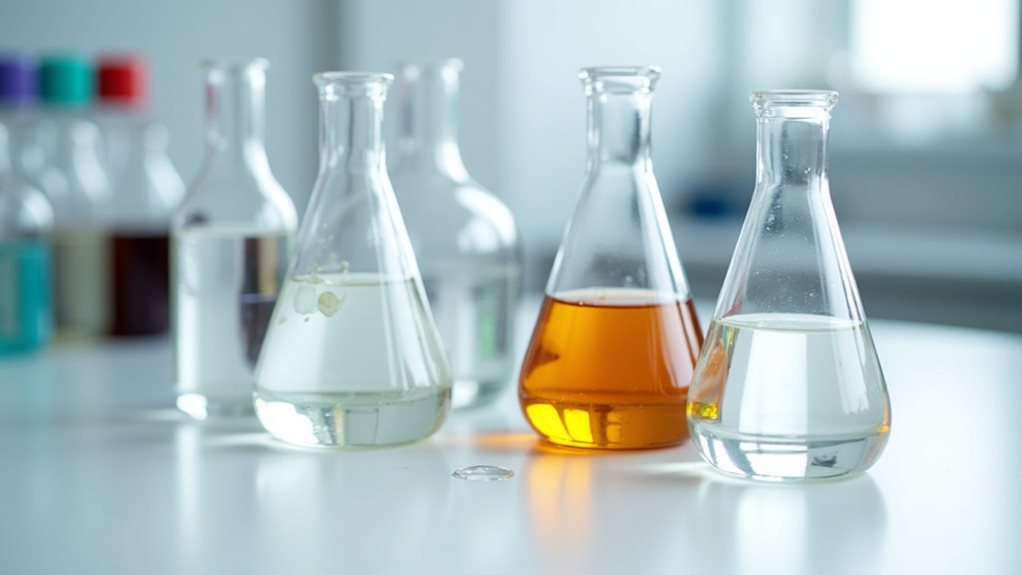
When you walk into your local dry cleaner with that favorite silk blouse or wool suit, you’re probably not thinking about the chemical soup it’s about to take a bath in, but maybe you should be.
Here’s the thing—most dry cleaners won’t volunteer information about their cleaning agents unless you specifically inquire, and honestly, I learned this the hard way after years of blindly dropping off clothes 🤦♀️.
Start by asking directly what solvent they use in their cleaning process; don’t accept vague answers like “eco-friendly” without specifics.
Don’t settle for vague “eco-friendly” claims—demand specific details about which solvents your dry cleaner actually uses on your garments.
Check their operating permits from local air quality departments, which typically list whether they use perchloroethylene or safer alternatives.
If they do use perc, understand that this chlorinated hydrocarbon is effective at removing oil-based stains but comes with environmental and health considerations that have prompted many cleaners to seek alternative solvents.
Knowledge is power, and your clothes (and health) deserve transparency.
